renz496
Champion
-Fran- :
renz496 :
Martell1977 :
-Fran- :
Even though that it's a great piece of hardware, it's heart is still a bad purchase IMO. If only Sapphire would make a 1080 or a 1080ti with that much care, it would sell out in a single second. AMD really needs to put out something that is worthy of their OEMs like Sapphire that really put pieces of hardware like that out there.
Cheers!
Cheers!
Hard to say Vega is bad considering it has higher IPC than nVidia's offerings, it's just power hungry. I've always read that the excess power is due to some extra resources AMD bakes in, which is also why they do so well in productivity.
with different architecture it is hard to tell which one have higher IPC. people often said AMD lower clock compared to nvidia for the same performance is proof AMD have much higher IPC but people ignore everything else. sure RX480/580 have much lower clock than GTX1060 but those RX also have more SP (2304 vs 1280) and die size wise polaris also bigger than GP106. with pascal nvidia able to push the clock over 2Ghz from maxwell that usually hit 1.4-1.5Ghz. nvidia using this high clock speed advantage to reduce the amount of CUDA cores for roughly the same performance. prime example is GTX980 vs GTX1060. IPC wise maxwell and pascal should be outright identical according to anandtech. but because of much higher clock speed GTX1060 was able to reach 980 performance with much less CUDA cores (2048 vs 1280). so with pascal nvidia was able to reduce their die size not only with node shrink but also because of the high clock speed.
I was going to give an argument along these lines as well.
The only thing I could add is, and it is unfortunate, that AMD has failed time and time again to make developers use their "special sauce" and optimize for it. So, even if it is there and you can get great benchmark numbers, it is moot if it is not really used in games. Or, if it is used, it doesn't add much to the overall image processing itself.
I do acknowledge saying it is a "bad" GPU is absolutely unfair, but you have to still compare them to their respective contenders at the price points being sold. In the context of the Sapphire Nitro+ Vega, it's just a bad purchase from the performance standpoint, even if it is a great piece of technology.
Cheers!
AMD needs feature that can be used automatically in games without any special tweak to use the said feature. async compute for example only accessible via DX12 or Vulkan. AMD not the only one have GPU utilization issue. nvidia to certain extend also face similar issue. the changes from kepler to maxwell for example one of the primary changes nvidia did to the SM layout was to increase GPU utilization (for gaming in general). but the changes that nvidia make did not need specific feature to be supported by games. hence it should benefit any games regardless of API being use.





